A Timeline for the
Upper Blue Mountains
Upper Blue Mountains
compiled by Jim Smith, 2002
introduction
spring
summer
autumn
winter
Spring
(September, October, November)
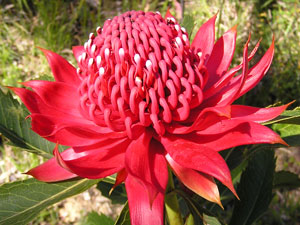 Waratah (Telopea speciosissima)
Waratah (Telopea speciosissima)
Weather:
September is the driest month. Equinox on 22 September.
Mammals:
Spring peak of Bush Rat, Rattus fuscipes, and Swamp Rat, Rattus lutreolus, numbers. Many juveniles born Aug/Sept.
Female Antechinuses with young → October.
Echidnas wander.
Brushtail Possums call (Spring → Autumn), mating.
Ringtail Possums, Sugar Gliders, Yellow-bellied Gliders and Pygmy Possums born (→ summer)
November: Antechinuses weaned.
Road kills as juvenile mammals disperse.
Reptiles and Frogs:
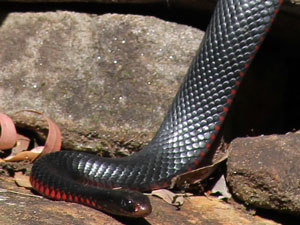 Red Bellied Black Snake
Red Bellied Black Snake
(photo: Phoebe Coster)
First snakes to emerge: Copperhead and Red-bellied Black Snake.
After equinox, Perons Tree Frogs call at night. In a good year Whistling Tree Frogs will call a few weeks after equinox too. i.e. calls can overlap.
Aquatic:
Female Crayfish with 'berries' (young)
September: First major hatching of Galaxias fry (in warmer Springs).
November: Second major hatching of Galaxias fry.
Insects:
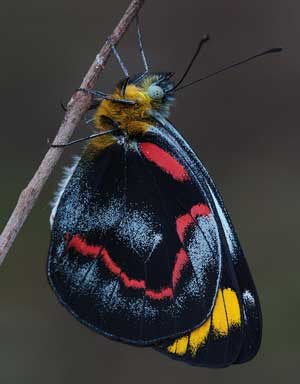 Black Jezebel (Delias nigrina)
Black Jezebel (Delias nigrina)
(photo: Robin Murray)
Imperial White Butterflies (Delias harpalyce), active (larvae feed on mistletoe). Red Ichneumonid Wasps (Netelia producta) swarm. Larvae is parasitic on moths.
Nellies Glen Butterflies mating on hilltops (Sept→Nov) e.g. at Pulpit Hill.
Cicadas emerge.
November: Common Brown Butterflies (Heteronympha merope) mating eggs dropped from air to grass Swordgrass Brown Butterflies (Tisophone abeona). Larvae on Ghania (swordgrass).
Caper White Butterfly migration to north-east (approx 22 Nov to December)
Tachinid Flies (mid November).
Whistling Moths (Hecatesia fenestrata) begin to call on hot nights before rain. Larvae feed on Dodder, Cassytha sp.
Christmas Beetles emerge.
Termites fly.
Birds:
September: Migrants return: Rufous Whistlers from Qld, Sacred Kingfishers from Qld,NG.
Southwards honeyeater migration peaks.
Satin Bowerbirds display, mate, lay eggs.
Rose Robins return to gullies.
Kookaburra calls increase.
Many juvenile New Holland Honeyeaters dispersing.
Channel-billed Cuckoos arrive.
October: Satin Flycatchers arrive from Qld, NG.
Black-faced Monarchs and Rufous Fantails arrive, from Qld, NG.
Koels arrive from Indonesia
November: Many young birds being fed.
Satin Bowerbirds hatching.
Silvereyes feed on Cedar Wattles (Acacia elata) extra-floral nectaries.
Plants:
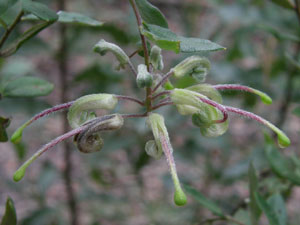 Green Spider Flower (Grevillea mucronulata)
Green Spider Flower (Grevillea mucronulata)
Epacridaceae flowers: Woolsia, Epacris microphylla, Epacris pulchella flower.
Leucopogon flowers perfume the air from September/October.
Peas flower: e.g. Bossiaea rhomboides.
Orchids: Sun Orchids (Thelymitra); Caladenia (Aug→Dec); Flying Ducks (Nov)
Endemics: Alania endlicheri; Sprengelia monticola; Epacris reclinata flower.
Miscellaneous: Mistletoes, Casuarinas, Grass Trees, Hibbertia sp. flower.
Boronia floribunda (Oct.)
Kunzia and Isopogon (late Oct.)
Black Ash (Eucalyptus sieberi) flowers (Oct/Nov).
Peppermint Gum (Eucalyptus piperita) flowers (Nov).
Introduced Elm trees release their winged seeds.
November:
Native Current fruit drops.
Christmas Bush flowers.
Waratahs flower.
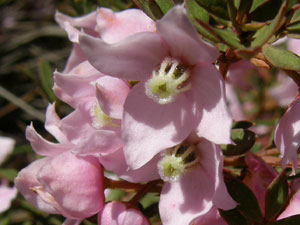 Pale Pink Boronia (Boronia floribunda)
Pale Pink Boronia (Boronia floribunda)
Rainforest canopy:
Coachwood, Sassafras flower (Sept), Wonga Vine (Oct)
New growth leaf of Coachwood is purple
New growth leaf of Possumwood is pink.
New growth leaf of Acacia elata is silvery.
© 2025 Blue Mountains Conservation Society Inc.
We acknowledge the traditional custodians of this land
– the Darug and Gundungurra people –
and pay respect to their Elders past, present and emerging.
If you'd like to give feedback about this page please contact: webmaster@bluemountains.org.au
– the Darug and Gundungurra people –
and pay respect to their Elders past, present and emerging.
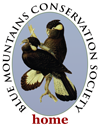
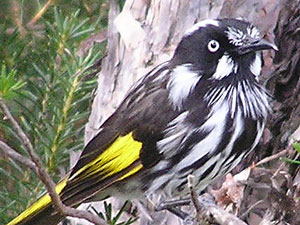 New Holland Honeyeater
New Holland Honeyeater